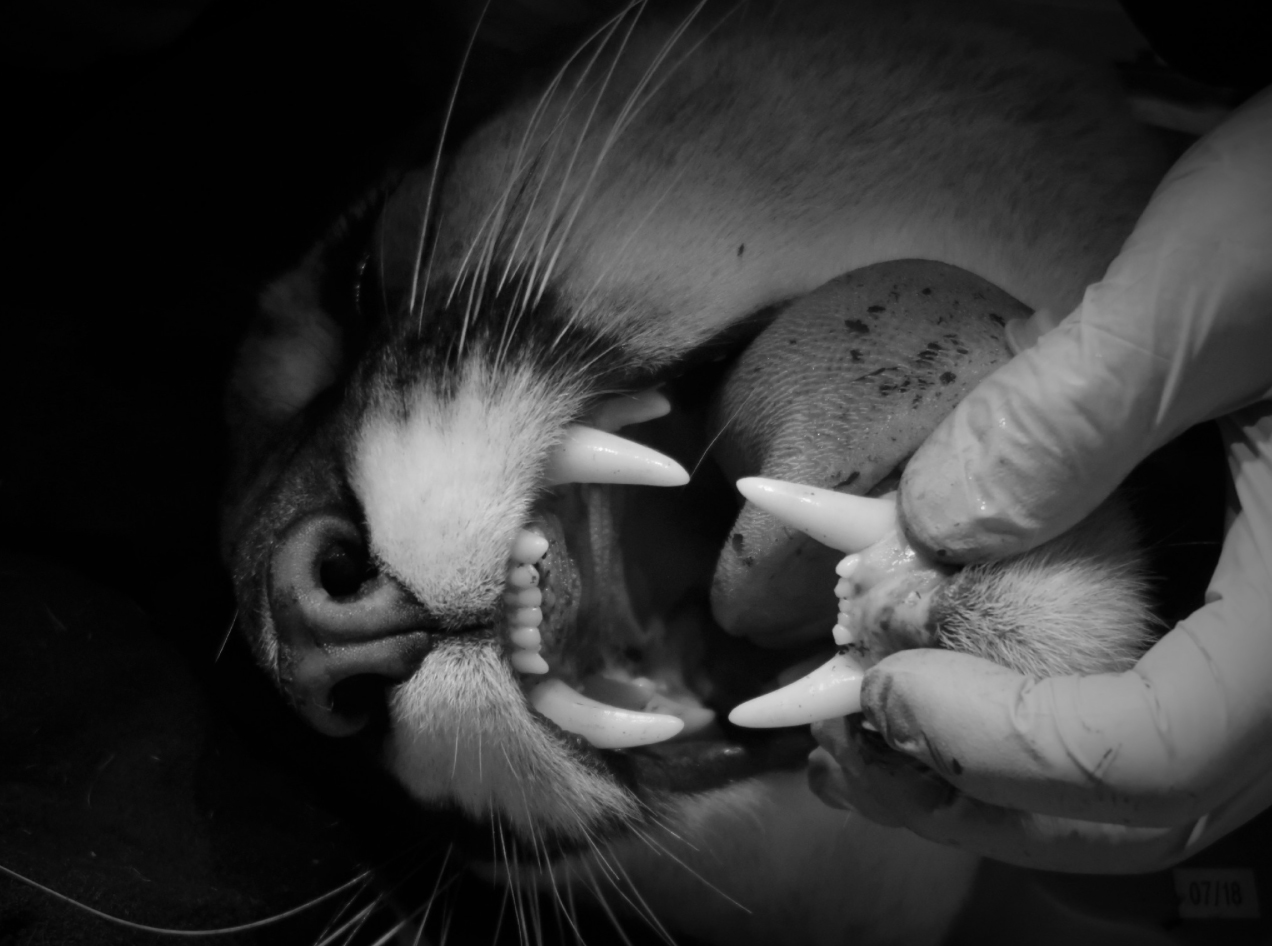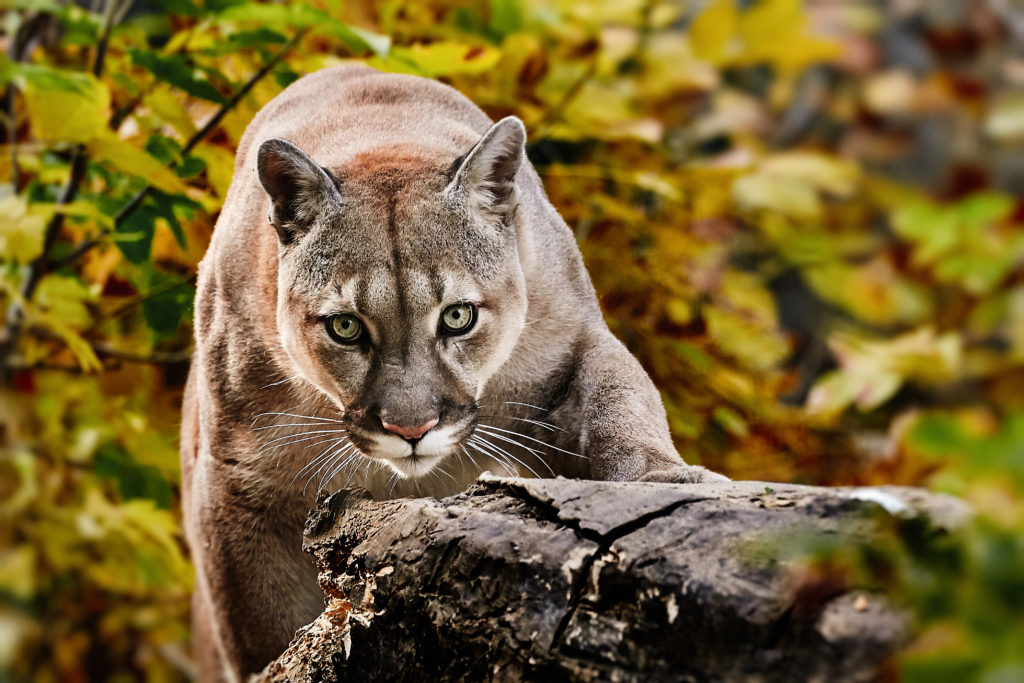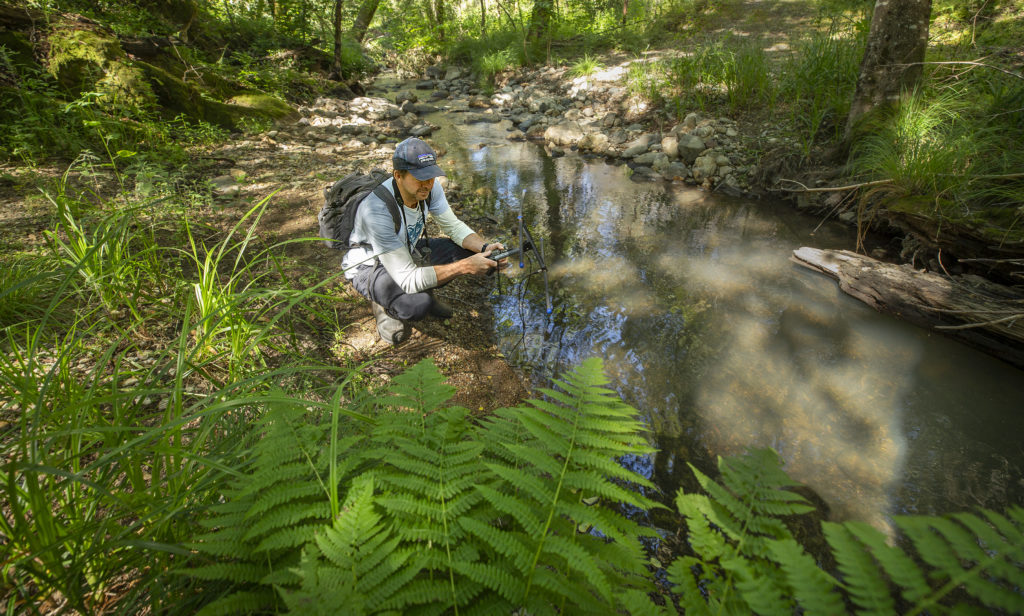They could not see the cat, but it was watching them. The day Jamie Burkart discovered the carcass of his goat, partially eaten and cached under a blackberry bush at the base of Sonoma Mountain, he put in a call to Quinton Martins, who showed up with a dead deer in his truck.
The deer would serve as bait for the big cat who’d taken Burkart’s goat. Martins, an easygoing South African outdoorsman and wildlife biologist, specializes in big cats. He specializes, more specifically, in saving them, by explaining the crucial role they play in preserving the balance of the ecosystems through which they range, and by reminding people that mountain lions have far more to fear from us than we do from them.
To save them, he first traps them, which is why Martins asked Burkart, quite matter of factly, if he knew how to quarter a deer. “I’d moved from San Francisco about a year earlier,” recalls Burkart, who works in the wine industry. “I have no idea how to quarter a deer.”
His buddy Stephen did. Stephen is an ex-Army Ranger with whom Burkart had already tracked the goat’s blood trail down a steep slope, across Matanzas Creek, over multiple fences, and up another steep embankment, “almost a cliff.”
The traps were set and baited. Not long after night fell, the mountain lion now known as P5 was in a cage.
“He’d been watching us the whole time,” Burkart believes.
It’s still easy for landowners in Sonoma County to get a depredation permit from the state’s Department of Fish and Wildlife, allowing them to kill a mountain lion. One need only show proof of the cats preying on livestock or pets.
For more than a century in the American West, the policy of ranchers toward livestock-killing big cats was summed up by an alliterative death sentence: “Shoot, shovel, and shut up.”
These days, that path is taken less frequently, in California in general and Sonoma County in particular. Some of the credit for this goes to Martins, a native of South Africa with a Ph.D. in Zoology who is the founder and director of an Audubon Canyon Ranch (ACR) project called Living with Lions.
By placing GPS collars on the big cats they trap — like the one placed around the neck of the cougar who made a meal of Burkart’s goat — Martins and his team of ACR scientists, local veterinarians, and volunteers are able to map their ranges and territories, and to identify critical wildlife corridors. This is an important aspect of the research done by Living with Lions, which ACR executive director John Petersen describes as a program that “touches all corners of our mission.” One of those corners, says Petersen, is “education of the community on how to co-exist with these top predators.”


Burkart, to be sure, had much to learn. The handful of pigs and goats on his 5-acre spread had access to a shelter that allowed them refuge from the rain. But it had no door, as Martins pointed out during his visit. “It was a quick fix,” says Burkart, who now blames himself for the loss of his goat. “That situation happened because of my ignorance. If I’m going to spend that much on animals, I can spend a little more and get a door.”
More than two years later, Burkart is still struck by the number of people in his community who don’t realize they are sharing the area with big cats. A woman who lives a half-mile from him lost several goats in a short period of time. She assumed someone was stealing them.
Exiting a Glen Ellen coffee shop recently, Martins came upon a woman who’d stopped to look at the cougar logo and slogan on his truck. “Did you know that you’re living with lions?” he asked, with a smile.
Indeed, she agreed, her husband believed he’d seen one while riding his mountain bike.
It’s a catchy slogan, but what does “Living with Lions” mean? What does it look like?
It looks like the juvenile male puma that took refuge in a planter outside the Santa Rosa Macy’s on B Street in April. Between the time they’re 10 to 18 months old, lions “disperse” to new territory. That is, they leave their mothers — or are forced by their mothers to leave. Those animals, like the cat at the mall, are far more vulnerable than adults. They’re on unfamiliar turf, their hunting skills aren’t yet fully honed. The adult males in their new area are not pleased to see them, and will sometimes kill them.
To avoid that fate, younger males sometimes range into what Martins described as “odd areas” — like a shopping mall on a Monday morning.
Living with lions means discovering, as Maria Cardamone did one morning in January, upon walking out to her pasture in Willow Creek, that both her llamas had been killed. She and her husband, Paul Matthews, have a barn, but the llamas disliked spending the night in it.
The bereaved couple had already met Martins, were familiar with his work, and reached out to him immediately.
To bait this trap, Martins would need some part of a llama carcass. But Matthews, showing admirable initiative, already had fired up his tractor and buried the victims.
“Sweetie,” Cardamone told him, after consulting with Martins, “you have to dig up Rocky.”
Following some initial resistance (“No effing way,” he’d replied), Matthews disinterred the llama, whose remains successfully lured the mountain lion, a large male cougar dubbed P14 — the 14th lion trapped by Martins in Sonoma County.
Two months later, P14’s collar showed he had roamed more than 200 miles, between Fort Ross, Guerneville, and Sea Ranch.
The experience proved educational for Cardamone.
“I mean, no one’s putting out cat chow for them,” she says. “The lion was being a lion.”
P14 was also being a lion some seven months later when he killed 12 sheep on a Point Arena property whose owner promptly requested a depredation permit. On July 29, P14 became the fourth collared mountain lion killed for livestock depredation since Living with Lions began its research in October 2016.


Such “mass depredation events,” Martins points out, occur when livestock are kept in enclosures that aren’t sufficiently predator-proof, and offer no escape routes.
“Ultimately,” he wrote on the ACR website, “the question our region grapples with is do we value top-carnivores — and the crucial role they play in our own survival — enough to plan for their welfare when we introduce pets and livestock into their range?
“For those of us who take on the responsibility of owning and caring for livestock or pets, we do it with the understanding that their welfare depends on the provision of a safe, predator-proof environment. We also know that if we value our wild neighbors, we must remain vigilant against creating an irresistible lure.”
To Martins, the messaging of Living with Lions is no less important than the research it conducts. That’s why the group posts maps of the cougars’ whereabouts, and videos of them in the wild. (“Mountain Lion Kittens Learning New ‘Big Cat’ Skills,” announced a recent headline on the ACR website.) The point is to allow the public to get to know, and even become emotionally invested in the big cats. It’s an unabashedly marketing-based approach, and not all conservation scientists are down with it.
Martins has “told us many times he wants his animals to be media stars,” says Greg Martinelli, lands program manager for the California Department of Fish and Wildlife, a Living with Lions partner. “There’s a difference between science and advocacy.” With Martins, he thinks, “those lines are a little blurred.”
Martins makes no apologies for his unorthodox approach. He believes that the focus of conservation in the years to come needs to be on marketing, and on recruiting entrepreneurs and leaders from beyond the environmental and nonprofit spaces — “the Bill Gateses and Elon Musks, people who have been incredibly successful in the corporate world.”
“This is the community that will end up finding the solutions, in the long run.” After all, he points out, “We’ve got the best product on the planet. We’ve got the planet!”
The man who seeks nothing less than to overhaul and defibrillate the conservation movement grew up in Welkom, South Africa, which he describes as “a crappy gold-mining town” 90 miles northeast of Bloemfontein. His happiest hours were spent outdoors, camping and fishing with his father.
“We used to go to some pretty cool, wild places, to go fishing,” Martins says. “I remember the connection to nature, just sitting quietly, enjoying that peace.
“For my sins,” he says with a smile, “I studied for a degree in law. In my third year, I realized it wasn’t my scene.”



Martins followed his heart back outdoors, and found work as safari guide. First he was a hunter, then a photographer on safari camps that involved no hunting. For close to 10 years, his “offices” were some of Africa’s wildest places, including the Okavango Delta, a World Heritage site in Botswana that’s home to rhinos, cheetahs, and lions.
Two things came into sharp focus for him during that decade: the importance to the planet of those vast wilderness areas, and his purpose on said planet. After earning a bachelor’s degree in zoology at the University of Cape Town, he launched the Cape Leopard Trust, a program similar to Living with Lions that has grown and thrived — after a shaky beginning.
Securing permission from the South African government to do his research proved less problematic, he found, than paying for it. Martins hocked many of his possessions to keep the leopard trust afloat. By March 2004, he’d sold his car and was crashing at his mother’s house in Cape Town and hitchhiking the 100-plus miles to the Cederberg Wilderness Area to do his fieldwork.
Later that year, when a trek took him onto the estate of a landowner, he called the man to tell him, “I was hiking out in the middle of nowhere and I kinda ended up on your property.” The landowner had heard of him, it turned out, and wanted to know more about his pet project.
“I was like, yeah, whatever,” says Martins, who by then was down to his last 57 rand — less than $4 — and had begun to lose hope. But he sent an email to that man, Johan van der Westhuizen, who then asked Martins for a meeting.
Suspecting it was a waste of time, he borrowed his brother’s car, drove to north Cape Town and sat down in the office of van der Westhuizen, who pushed a check for 15,000 rand — about $2,200 — across the desk to him. “He told me, ‘I really want you to carry on this work,’” Martins recalled, “And I burst into tears.”
Van der Westhuizen remembers that meeting, and remains in awe of his friend’s “remarkable focus” and “dedication and passion for his chosen journey in life.”
With today’s remote technologies not yet available, Martins “had to physically check his cameras and cages in the roughest mountain ranges, to a point of total burnout. Yet he doggedly soldiered on,” recalls Van der Westhuizen. He judges the leopards of South Africa’s western cape as lucky “that Quinton arrived to champion their cause.” The big cats of Northern California, he believes, are just as lucky.
In 2008, a sixth-grade teacher named Liz Bond drove to the Cederberg wilderness to recharge after a draining week. Upon returning from a long hike the following day, she met the person other backpackers had referred to as “the Leopard Man.” This was Martins, who told her, “I’m sure I know you from somewhere.”
Bond’s initial reaction: “I thought, ‘That’s a pretty lame pickup line.’ But later we figured it out.” They’d been in an archaeology class together at the University of Capetown.
Bond was headed home, until Martins talked her into staying an extra day, which turned into several days. Three months later, they were engaged.
Late in 2014, after 11 years running the Cape Leopard Trust, they moved to the Bay Area. Martins felt a strong pull to Northern California, whose financial and intellectual resources make it, in his opinion, “probably the most important place in the world in terms of the potential to come up with more successful conservation strategies.”
“What’s so great about this state,” he says, “is that you don’t feel alone in having a big vision. You feel anything is possible. People make it work.”
Not everyone shares his vision. In February, Patricia Damery discovered the grisly remains of her beloved goat, Dasher, on her ridgeline property in the Napa area. She is an author and self-described biodynamic farmer whose ideals — “live with nature, not against it” — were put to the test that day.
Damery’s first reaction was less biodynamic than Biblical — as in “eye for an eye.” Her two grandsons had been playing with friends around that same goat pen the previous evening. Her first instinct, she recalls, “was to protect them all.”
At her invitation, a trapper set up a cage on the property, baiting it with parts of the freshly killed goat. The trapper also began the process of applying for a depredation permit. Once the permit was issued and the mountain lion caged, the trapper would be required by law to kill it.
Meanwhile, on the advice of a friend, Damery called Martins, who persuaded her there was a better way. He assured her that killing one mountain lion wouldn’t keep others away, though it would throw that area’s ecosystem out of whack. He also made the point that it is the landowners’ responsibility to secure their animals, to shelter them from marauding predators.
She changed her mind, resulting in an awkward conversation with the trapper, who’d spent five hours on her property, only to be instructed to please close and remove his trap because Martins and his team would be taking over.
Then came the call at 1:30 a.m. “There’s a lion in the cage,” Martins told her. “We’ll be there shortly. Do not go down there.”
Working with local veterinarian Graham Crawford to gauge the animal’s age and weight, the team settled on the proper dose of anesthetic, then darted the cat, an 80-pound male. Once it was unconscious, the lion was placed on a tarp. Martins and his team went into action. Blood samples were taken. Its limbs, girth, and teeth were measured. All of this, Crawford says, takes 45 to 50 minutes. As the 15th and most recent lion collared by Living with Lions, he was known thereafter as P15.
“We even examined his teeth,” Damery recalls. The Living with Lions team suggested she name the lion, whom she dubbed Jupiter. “I just fell in love with that lion, even though it had just killed my goat,” she says.
The naming, touching, and bonding with lions are practices “we tend to have a little bit of an issue with,” says Martinelli of the state’s fish and wildlife department.
“These are not pets,” he says. “They’re not owned by anyone. They’re wild animals.” Less than a week later, P15 was shot dead some 20 feet from the front door of a Napa property where it already had killed sheep on two previous nights. The man who fired the shot was a seasoned hunter. He and his wife are the parents of three young children.
“As a parent,” Alejandra Calderon says, “I hope that they understand how scared we were in the moment. It was a scary experience.”
Still, she and her husband were vilified on social media. The couple had defenders, but fewer of them. One of them is Eric Dicke, whose family has been ranching in Sonoma County since 1867. A road building contractor based in Healdsburg, he has a small number of sheep. He’s also been a state-licensed trapper of coyotes and mountain lions since 1983.
“This whole issue has become so politicized,” he says. “You either love mountain lions or you hate ’em. Well, I love mountain lions, but I don’t love them in my livestock.”
He’s met and talked to Martins, who has echoed his point that landowners have a responsibility to shelter their animals from predators. That’s fine if you’ve only got a handful of animals, Dicke says.
“But if you’ve got three or four hundred sheep, it’s not practical” he adds, for many ranchers to build a barn big enough for protection.
Joe Pozzi, a rancher who owns and manages grazing lands in western Sonoma and Marin counties, agrees that it’s simply “not practical” to house a large flock. “They’re grazing animals,” he says of his sheep, “and every day they’re moving to a different part of the ranch. They bed down in different areas.”
“Lions are beautiful animals,” he went on. “Nobody wants to go hunt ’em all down. [But if ] something comes into your flock, or your herd, economically, you have to deal with it. That’s the reality of it. “Those animals pay your bills. You do whatever you can to protect them.”
“There’s a long history, on the range, of taking care of predators,” says Tony Nelson, a wildlife ecologist and Sonoma Land Trust’s stewardship program manager.
By “taking care of,” he means exterminating. “Some of it is cultural, and some of it is practical.”
But large-scale ranching operations aren’t the lions’ biggest threat, he believes. “I don’t think you can lay it at the door of the ranchers. A lot of the depredation I’ve heard about is done by people who have 10 acres and 15 sheep.”
The threats to mountain lions are numerous, and widespread. In June, two conservation groups formally petitioned California’s Fish and Game Commission to protect imperiled cougar populations in Southern California and on the Central Coast, where habitat loss and fragmentation caused by freeways and sprawl have led to high levels of “genetic isolation and human-caused mortality,” according to Tiffany Yap, a scientist at the Center for Biological Diversity.
“Without a clear legal mandate to protect mountain lions from the threats that are killing them and hemming them in on all sides,” she says, “these iconic wild cats will soon be gone from Southern California.”
While they may not be exactly thriving, the mountain lions of the North Bay are in better shape than big cats elsewhere in the state. “Up here,” explains Nelson, “we don’t have communities and highways to the extent Southern California does, so it’s not quite the same.”
The cougars are assisted, immeasurably, by the 5-mile-long ribbon of land stretching west to east from Sonoma Mountain down to Sonoma Creek and the valley floor near Glen Ellen, then up to the crest of the Mayacamas Range. This 5,000-acre strip, known as the Sonoma Valley Wildlife Corridor, is a patchwork of state and regional parks, open spaces, and easements. It allows wildlife, and plant life, (relatively) safe movement between large blocks of core habitat, Nelson says. “These corridors enable animals to escape predators, find mates, and locate better habitat.”
They’re especially important to wide-ranging big cats. Territories for some males cover hundreds of square miles. When their range is confined, populations — and gene pools — become isolated.
The importance of these “connectivity” corridors was underscored, in frightening fashion, on July 19, when the driver of a pickup struck a mountain lion around 10:30 pm on Highway 29 in Lake County. After hitting the big cat, the truck slid sideways at a high speed into the path of an SUV. Nine people were hospitalized, four with major injuries. The mountain lion was killed.
Martins had spent his adult life tracking and trapping apex predators. It was only a matter of time before misfortune struck.
After parking and exiting his vehicle on a Hood Mountain ridge in late June, he’d taken a couple steps when he noticed the truck was rolling.
Fearing it would go careening down the hillside and “and set the mountain on fire again,” he sprinted back, opened the door, and turned the steering wheel.
At that point the pickup went up on two wheels, then rolled — with Martins inside it. Upon regaining consciousness, he hiked down the mountain to his house, where he asked Liz to accompany him back up to the truck, which had come to rest on its side. He was intent on tipping it back onto its wheels.
“No way,” replied Liz, after taking a look at him. Instead, she took him to the emergency room, where he underwent X-rays and a CT scan.
Did he get the CT scan to see if he had a brain bleed?
“To see if I had a brain,” he replied, sheepishly.
A week later, he and Liz and their 7-year-old daughter flew to Africa, where he spent six weeks as
a group leader of “handcrafted African safaris,” as it says on the website of True Wild. That’s the name of the Martins’ 2-year-old safari planning company — a business that dovetails, he says, with the mission and purpose of Living with Lions.
These expeditions, to wilderness areas like the Oka- vango Delta in Botswana and camps in the Luangwa and Zambezi valleys in Zimbabwe, are designed
“to put wilderness and conservation into a broader perspective” for their clients, who pay top dollar — around $1,000 a day — for that opportunity.
“You’ve got them unplugged for two weeks,” he says. “There’s no need for elevator pitches, you’re sitting around the fire, drinking single malt whiskey, listening to lions calling, and looking at these incred- ible stars.”
Thusly awakened, his clients will be motivated to join the grand battle, Martins hopes. “There are amazing, innovative people out there who don’t even realize that they are key to sorting this out, to helping to pull the emergency brake ….”
“Actually,” he says, “maybe I don’t want to use that analogy.”


















